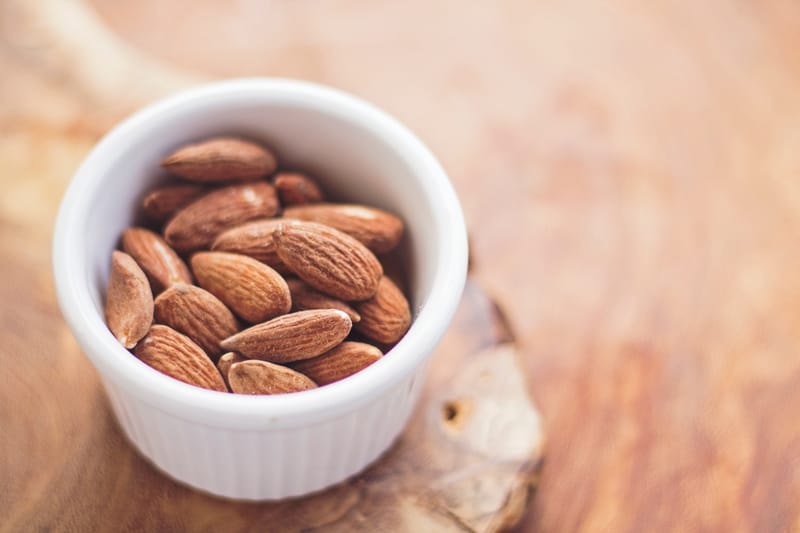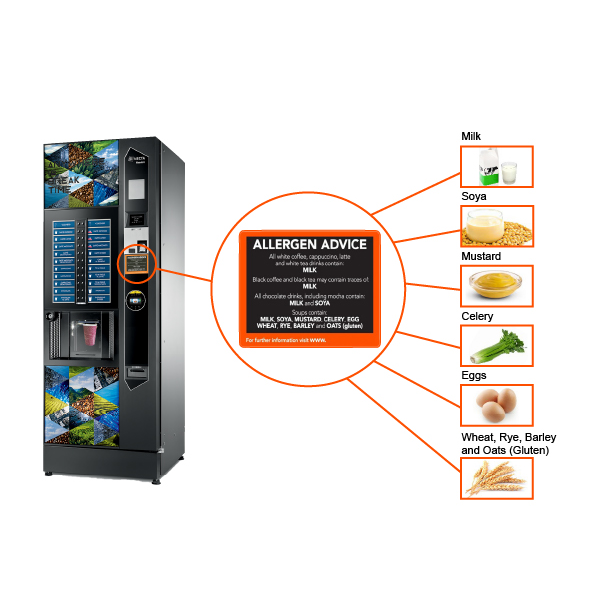Allergens in our Vending

Allergen labelling on foods changed on December 13th, 2014, due to the introduction of the Food Information Regulation. Legislation requires businesses to provide information about allergenic ingredients used in any food product they sell or provide. An allergic reaction to food can happen when your immune system mistakenly thinks that certain food is a threat to your body.
A food intolerance doesn’t usually involve your immune system; however, coeliac disease is an intolerance to gluten and does involve the immune system. A classical food allergy is characterised by a sudden reaction that develops upon or soon after exposure to reactive food particles (antigens). This type of allergic reaction occurs when the body’s immune system recognises certain foods as harmful. After eating (or in some cases even touching or inhaling reactive food), specific Immunoglobulin E (IgE) antibodies respond to the presence of antigenic material (perceived dangers) by triggering the release of histamine and other inflammatory chemicals into the tissues. Manifestations of this immune response can vary with symptoms ranging from skin irritation and rashes to breathing difficulties and anaphylactic shock. The most common instances of IgE mediated food allergy are to nuts, shellfish, fish, cow’s milk, egg, and wheat flour. This type of allergy often runs in families and in some cases, reactions can be severe and even life threatening. Total avoidance of reactive foods is the only way to prevent food allergy reactions and complications.
There are 14 major allergens which need to be mentioned when they are used as ingredients as food.
 | Celery: This includes celery stalks, leaves, seeds and the root called celeriac. Celery can be found in soups, celery salt, salads, some meat products and stock cubes. |  | Molluscs: These include mussels, land snails, squid and whelks, but can also be commonly found in oyster sauce or as an ingredient in fish stews. |
 | Cereals containing Gluten: Wheat (such as spelt and Khorasan wheat/Kamut), rye, barley and oats is often found in foods containing flour, such as some types of baking powder, batter, breadcrumbs, bread, cakes, couscous, meat products, pasta, pastry, sauces, soups and fried foods which are dusted with flour. |  | Mustard: Liquid mustard, mustard powder and mustard seeds fall into this category. This ingredient can also be found in breads, curries, marinades, meat products, salad dressings, sauces and soups. |
 | Crustaceans: Crabs, lobster, prawns and scampi are crustaceans. Shrimp paste, often used in Thai and South-east Asian curries or salads, is an ingredient to look out for. |  | Nuts: Not to be mistaken with peanuts (which are actually a legume and grow underground), this ingredient refers to nuts which grow on trees, like cashew nuts, almonds and hazelnuts. You can find nuts in breads, biscuits, crackers, desserts, nut powders (often used in Asian curries), stir-fried dishes, ice cream, marzipan (almond paste), nut oils and sauces. |
 | Eggs: Eggs are often found in cakes, some meat products, mayonnaise, mousses, pasta, quiche, sauces and pastries or foods brushed or glazed with egg. |  | Peanuts: Peanuts are actually a legume and grow underground, which is why it’s sometimes called a groundnut. Peanuts are often used as an ingredient in biscuits, cakes, curries, desserts, sauces (such as satay sauce), as well as in groundnut oil and peanut flour. |
 | Fish: You will find this in some fish sauces, pizzas, relishes, salad dressings, stock cubes and Worcestershire sauce. |  | Sesame seeds: These seeds can often be found in bread (sprinkled on hamburger buns for example), breadsticks, houmous, sesame oil and tahini. They are sometimes toasted and used in salads. |
 | Lupin: Lupin is a flower, but it’s also found in flour. Lupin flour and seeds can be used in some types of bread, pastries and even in pasta. |  | Soya: Often found in bean curd, edamame beans, miso paste, textured soya protein, soya flour or tofu, soya is a staple ingredient in oriental food. It can also be found in desserts, ice cream, meat products, sauces and vegetarian products. |
 | Milk: Milk is a common ingredient in butter, cheese, cream, milk powders and yoghurt. It can also be found in foods brushed or glazed with milk, and in powdered soups and sauces. |  | Sulphur dioxide (sometimes known as sulphites): This is an ingredient often used in dried fruit such as raisins, dried apricots and prunes. You might also find it in meat products, soft drinks, vegetables as well as in wine and beer. If you have asthma, you have a higher risk of developing a reaction to sulphur dioxide. |
How these new Allergen rules apply to vending
These new allergen rules will apply to coffee machines with loose ingredients. Can, bottle; snack and any pre-packed products will fall outside these rules. At North West Vending we introduced clear and precise labelling on all our beverage vending machines that identifies any of the 14 allergens that may be present in the products sold in the machine.
On all our machines customers will see clear allergen labelling for all the ingredients in our hot beverage machines.
There are 14 major allergens which need to be mentioned when they are used as ingredients as food.

The Allergens present in our hot beverage drinks. All our milk based drinks contain MILK, including drinks made using a whitener. Find the full list below.
Allergens in our Hot Beverages.pdf